Nature's canvas at Saturn
Nov 29:
In a splendid portrait created by light and gravity, Saturn's lonely moon Mimas
is seen against the cool, blue-streaked backdrop of the planet's northern hemisphere.
Delicate shadows cast by the rings arc gracefully across the planet, fading
into darkness on Saturn's night side.
 FULL STORY FULL STORY
 |  |
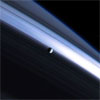
|
 |
Precocious black holes challenge theories
Nov 27:
NASA's Chandra X-ray Observatory has obtained definitive evidence that a distant
quasar formed less than a billion years after the Big Bang contains a fully-grown
supermassive black hole generating energy at the rate of twenty trillion Suns.
 FULL STORY FULL STORY
 |  |

|
 |
Battered and grooved: Saturn's moon Tethys
Nov 27:
Having now passed closer to Tethys than the Voyager 2 spacecraft, Cassini has
returned the best-ever natural colour view of this icy Saturnian moon.
 FULL STORY FULL STORY
 |  |
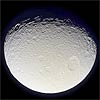
|
 |
Seismic shaking erased small craters on asteroid
Nov 26:
University of Arizona scientists have discovered why Eros, the largest near-Earth
asteroid, has so few small craters. The Near Earth Asteroid Rendezvous (NEAR)
spacecraft mission orbited Eros for up-close research.
 FULL STORY FULL STORY
 |  |

|
 |
Hovering over Titan
Nov 24:
A mosaic of nine processed images recently acquired during Cassini's first very
close flyby of Saturn's moon Titan constitutes the most detailed full-disc view
of the mysterious moon. The mosaic was released this week.
 FULL STORY FULL STORY
 |  |
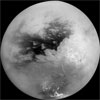
|
 |
Breathtaking vista of Tethys
Nov 23:
This dazzling view from Cassini looks beyond gigantic storms near Saturn's south
pole to the small but clear disc of Tethys. Clouds and ribbons of gas swirl
about in the planet's atmosphere in the foreground, while a tremendous chasm
is visible on the icy moon.
 FULL STORY FULL STORY
 |  |
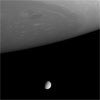
|
 |
Cassini image shows Saturn moon with a real shiner
Nov 22:
Saturn's moon Rhea shows off the moon equivalent of a black eye — a bright,
rayed crater near its eastern limb — in this picture from the Cassini
mission released November 22nd. Rhea is about half the size of Earth's
moon.
 FULL STORY FULL STORY
 |  |
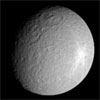
|
 |
A closer look at black holes
Nov 18:
An international team led by an Edinburgh astronomer have discovered that by
studying polarized light from black holes they can focus much more closely on
what exactly is going on around them.
 FULL STORY FULL STORY
 |  |

|
 |
Cassini sees Atlas, Pandora and Janus orbiting Saturn
Nov 17:
Saturn hosts its own miniature solar system, with an entourage of more than 30
moons. This image shows Saturn's A and F rings, along with three of the moons
that orbit close to them.
 FULL STORY FULL STORY
 |  |
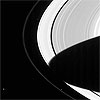
|
 |
European probe arrives in orbit around the Moon
Nov 16:
The European Space Agency's SMART-1 spacecraft is successfully making its first
orbit of the Moon. Powered by an ion engine, this craft is demonstrating technologies
for future planetary missions.
 FULL STORY FULL STORY
 |  |

|
 |
James Webb mirror building moves ahead
Nov 15:
NASA's James Webb Space Telescope (JWST) moved a major step forward with the
opening of a state-of-the-art facility in Alabama that will machine the observatory's
optical components. Northrop Grumman Corporation is the prime contractor for
JWST, leading the observatory's design and development team under contract to
NASA's Goddard Space Flight Center.
 FULL STORY FULL STORY
 |  |

|
 |
Black hole found to
precede galaxy bulge
Nov 14:
Astronomers using the Very Large Array radio telescope to study the most distant
known quasar have found a tantalizing clue that may answer a longstanding cosmic
chicken-and-egg question: which came first, supermassive black holes or giant
galaxies?
 FULL STORY FULL STORY
 |  |

|
 |
Martian moon Phobos in colour for close-up look
Nov 12:
The European Space Agency's Mars Express spacecraft has taken high-resolution
pictures of the Martian moon Phobos. The pictures show new detail that will
keep planetary scientists busy for years, working to unravel the mysteries
of this moon.
 FULL STORY FULL STORY
 |  |

|
 |
Astronomers make a star
Nov 12:
The Hale Telescope on Palomar Mountain has been gathering light from the depths
of the universe for 55 years. It finally sent some back early last week as a
team of astronomers created an artificial star by propagating a 4-watt laser
beam out from the Hale Telescope and up into the night sky.
 FULL STORY FULL STORY
 |  |

|
 |
Mysterious 'baby' planet
Nov 11:
In June, researchers announced they had located a potential planet around another
star so young that it defied theorists' explanations. Now a new team of planet-formation
specialists are backing up the original conclusions, saying they've confirmed
that the hole formed in the star's dusty disk could very well have been formed
by a new planet.
 FULL STORY FULL STORY
 |  |

|
 |
Hubble tracks asteroid
Nov 11:
While analyzing Hubble Space Telescope images of the Sagittarius dwarf irregular
galaxy, an international team of astronomers were surprised to see the trail
of a faint asteroid that had drifted across the field of view during the exposures.
The trail is seen as a series of reddish arcs on the right in this Advanced
Camera for Surveys image.
 FULL STORY FULL STORY
 |  |

|
 |
Spitzer discovery is good news for planet Pluto
Nov 10:
Pluto's status as our solar system's ninth planet may be safe if a recently discovered
Kuiper Belt Object is a typical "KBO" and not just an oddball. Astronomers have
new evidence that KBOs are smaller than previously thought.
 FULL STORY FULL STORY
 |  |

|
 |
Keck reveals Uranus ring, atmospheric fireworks
Nov 10:
As summer draws to a close in the southern hemisphere of Uranus, storm clouds
are brewing in the upper atmosphere, northern hemisphere winds are gusting to
250 miles per hour, and the planet's rings are getting brighter every day.
 FULL STORY FULL STORY
 |  |

|
 |
Objects, density waves seen in Saturn's rings
Nov 9:
A University of Colorado at Boulder-built instrument riding on the Cassini-Huygens
spacecraft is being used to resolve objects in Saturn's rings smaller than a football
field, making them twice as sharp as any previous ring observations.
 FULL STORY FULL STORY
 |  |
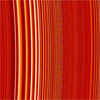
|
 |
Spitzer telescope looks into dark and dusty places
Nov 9:
Two new results from NASA's Spitzer Space Telescope released Tuesday, November 9th,
are helping astronomers better understand how stars form out of thick clouds of gas
and dust, and how the molecules in those clouds ultimately become planets.
 FULL STORY FULL STORY
 |  |

|
 |
Cassini observations show dynamic dance at Saturn
Nov 8:
A University of Colorado at Boulder professor involved with the Cassini-Huygens
mission is reporting an ever-changing vista at the frontiers of Saturn, featuring
wayward moons, colliding meteoroids, rippling rings and flickering auroras.
 FULL STORY FULL STORY
 |  |
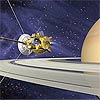
|
 |
Cassini radar sees flow-like feature across Titan
Nov 8:
A strikingly bright, lobate feature has turned up in one of Cassini's first radar
images of Saturn's moon Titan. It looks like something that "oozed across the
surface," says a radar team member.
 FULL STORY FULL STORY
 |  |

|
 |
Origin of cosmic rays revealed with gamma rays
Nov 7:
A team of U.K. astronomers working with international partners has produced the first
ever image of an astronomical object using high energy gamma rays, helping to solve
a 100-year-old mystery — an origin of cosmic rays.
 FULL STORY FULL STORY
 |  |

|
 |
Crunch, squelch or splash on Saturn's moon Titan?
Nov 6:
The prospect of the Huygens probe landing on a hard, soft or liquid surface when
it lands on Titan next January still remain following further analysis of data
taken during the Cassini mother ship's closest encounter with Saturn's largest moon
during its fly-by on October 26th.
 FULL STORY FULL STORY
 |  |

|
 |
Radar image shows Titan's surface live and in colour
Nov 6:
Saturn's moon Titan shows a sharp contrast between its smooth and rough edges
in a new false-colour radar image. Titan's surface lies beneath a thick coat of
hazy clouds, but Cassini's radar instrument can peer through to show finer
surface features.
 FULL STORY FULL STORY
 |  |

|
 |
Hubble spots rare triple shadow transit on Jupiter
Nov 4:
At first glance, Jupiter looks like it has a mild case of the measles. Five spots
— one coloured white, one blue, and three black — are scattered
across the upper half of the planet. Closer inspection by NASA's Hubble Space
Telescope reveals that these spots are actually a rare alignment of three of
Jupiter's largest moons — Io, Ganymede, and Callisto — across the
planet's face.
 FULL STORY FULL STORY
 |  |

|
 |
Mt Stromlo opens to public as re-build begins
Nov 1:
Ferocious bushfires decimated the historic Mount Stromlo observatory on the western
outskirts of Canberra, Australia, on January 18th, 2003. Now a new chapter is
being written in Australian scientific history with the establishment of new
buildings at the site which was re-opened to the public on October 30th, 2004.
 FULL STORY FULL STORY
 |  |

|
 |



